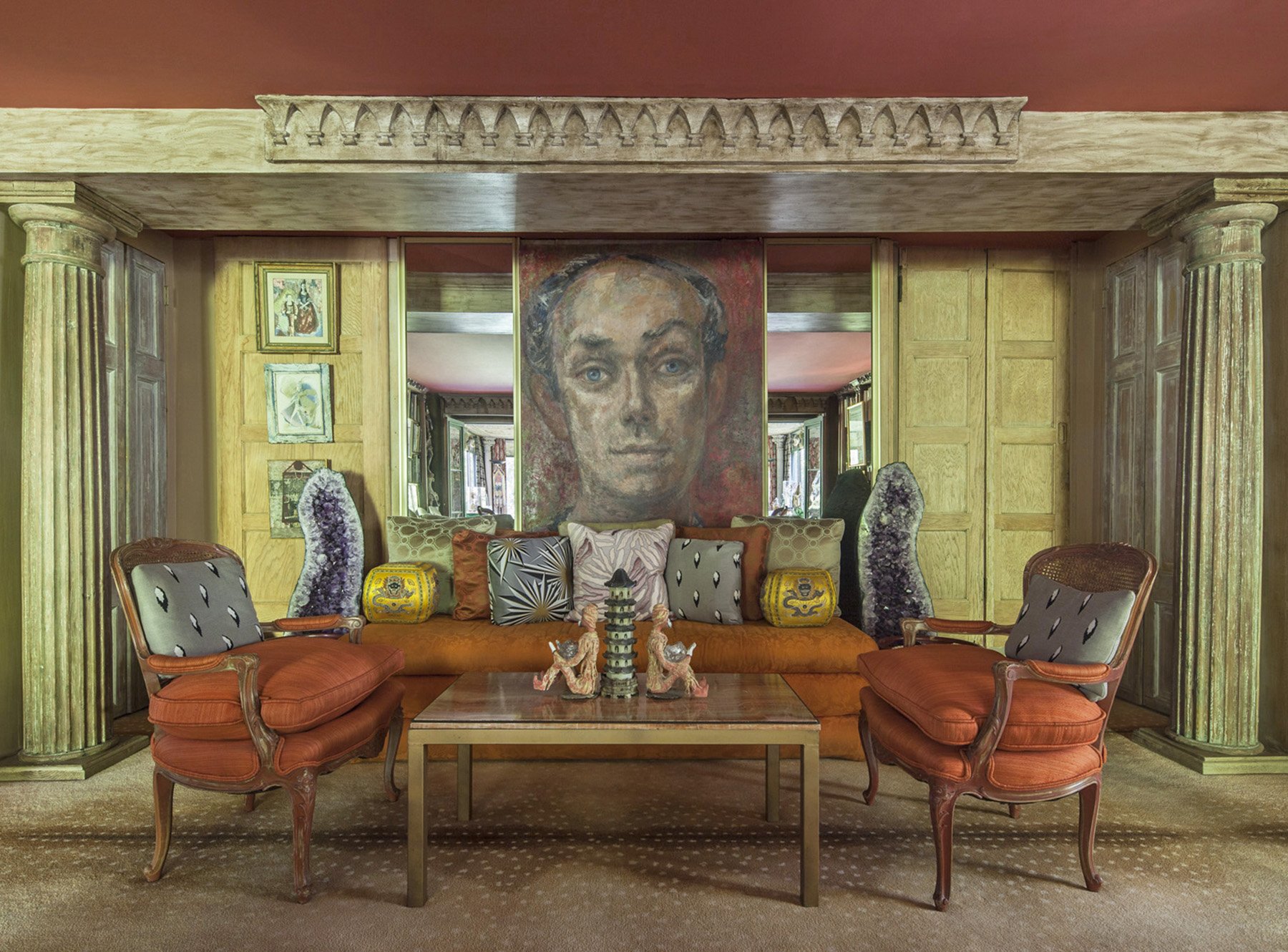
On becoming iridescent: Tony Duquette’s DAWNRIDGE
by Victoria Thomas
In January, 2024, Soolip received a rare invitation to lunch one-on-one with Hutton Wilkinson, the author of the deliriously gorgeous book, “Tony Duquette’s DAWNRIDGE” (Abrams New York, foreword by Hamish Bowles, photographs by Tim Street-Porter), at the former residence of artist Tony Duquette which Wilkinson and his wife Ruth now own, perched on winding street of the same name high above the Beverly Hills Hotel.
Wilkinson, who began an apprenticeship to Duquette when he was 17, suggests that the exact square footage of the property is unknown and seems impossible to measure. Modern technology could probably find a way. Suffice it to say that the location, now headquarters for the late Duquette’s several eclectic design companies helmed by Wilkinson, is perhaps surprisingly small, originally only 900 square feet before Duquette built some small additions. But here’s where the standard forms of measurement may fail. The narrow entrance foyer, a mere 10 feet by 10 feet, seems to expand and dissolve like Alice’s rabbit hole as we plunge into the swoony opalescence of the Duquette legacy. Perhaps the only instruments for mapping such a place of the imagination are a kaleidoscope, a Ouija board, a mood-ring and a runcible spoon.

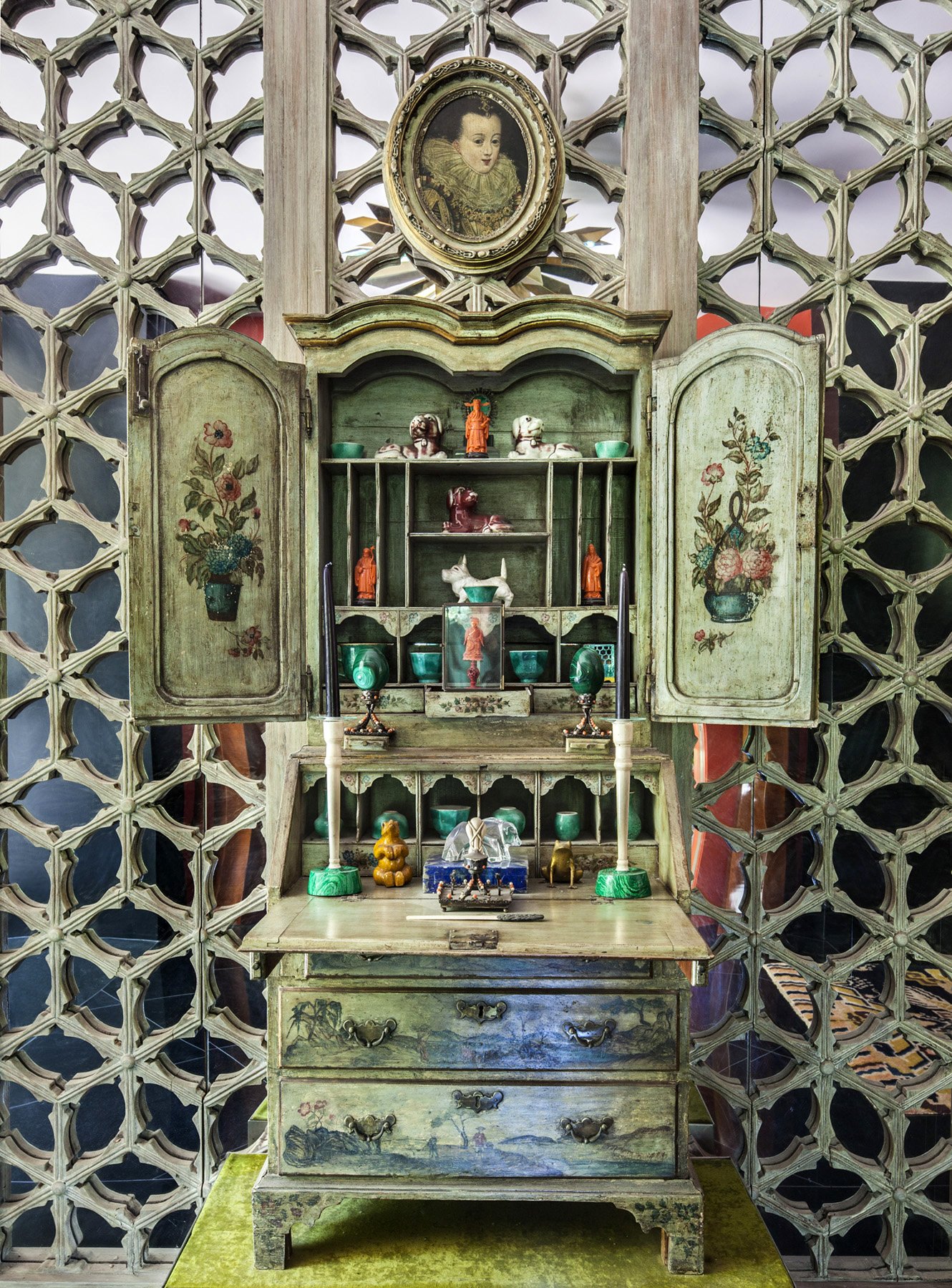
And suddenly, we’re in a salle des fête with a soaring ceiling and a decor so complex that one’s eye skitters and ricochets like a deranged frisbee. Gradually, an overall fusion motif emerges, somewhere between that of a Balinese boathouse and an overstuffed Victorian cabinet of curiosities, with an old-school touch of Trader Vic’s. Duquette coined the term “Chow Fun” to describe his gleefully grandiose, pop-Orientalist oeuvre.
Wilkinson, who worked with Duquette for three decades, moves gracefully around the space as our guide, elegantly dressed in velvety, wide wale corduroy trousers in a coral tone, a lilac shirt with crisp white collar, and a fawn-colored jacket. Without his telling us, we detect his royal bearing. In one of the rooms, we observe his family coat of arms, leading us from Beverly Hills to Bolivia to colonial Spain, where the crest was created in 1769 for the Counts of Alastaya. In 2008, King Juan Carlos of Spain bestowed the hereditary title of “Conde” de Alastaya upon Wilkinson.
When I ask if there’s a jewelry room, he laughs merrily. “Oh, honey, please!” says Wilkinson, “there’s a jewelry room at the bank.”
Insouciance and sprezzatura continue to play in this space 25 years after Duquette’s death by heart attack at age 85. Although both he and Wilkinson moved in rarified circles of celebrity and wealth, Duquette was irreverent to the degree that one could say he invented an entirely new genre of decor: trompe-l’Tony. This trickster approach exemplifies the quicksilver Gemini (birthdate, June 6, 1914) essence of Duquette’s tireless creative process now carried on by Wilkinson, who is himself a jewelry and textile designer and antiquities collector and restorer.
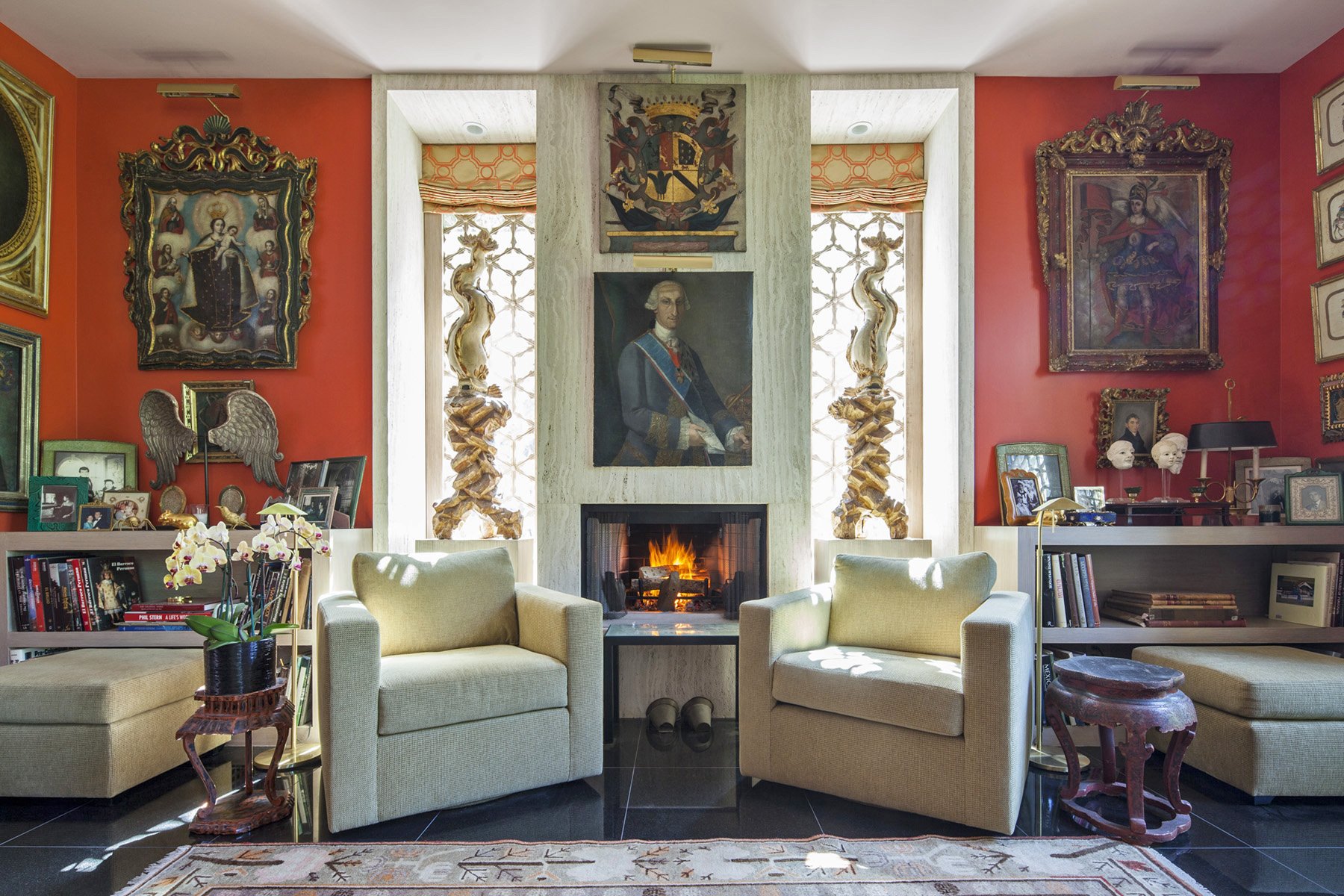
Here at Dawnridge, things are rarely what they seem.
Duquette displayed his knack for creating convincing fantasy early in a career which may best be described as surreal. While in his 20s, Duquette was employed as a salesman at the iconic Bullocks Wilshire, California’s cathedral of fine retailing owned by P.G. Winnett, great uncle of Hutton Wilkinson. Quickly moving into the role of display designer, Duquette reasoned that the fashion-conscious women of Los Angeles looked east to frosty Manhattan and Paris as the epicenters of style, coveting the glamour of furs, gloves, hats, boots, the plush density of cashmere, angora, alpaca and fine woolen tweeds, but deprived of the cold weather in which to wear them. His response was to crank up the store’s air-conditioning year-round in order to sell deliciously wintry women’s wear.
“We love beauty here, not necessarily luxury,” says Wilkinson when we admire a baroque light fixture fitted with translucent amber sconces. He plucks one from its ring to show me: “Plastic, darling. From what used to be called Pic and Save.” He shrugs and points to the ceiling which gleams with a gilded Venetian finish. He explains that a fire next door-- fires seemed to follow Duquette – resulted in smoke damage to the room. Duquette liked the effect of the damage, and simply shellacked over it. Elsewhere in the house, the dappled, golden veneer is echoed in jaguar-spotted carpeting.

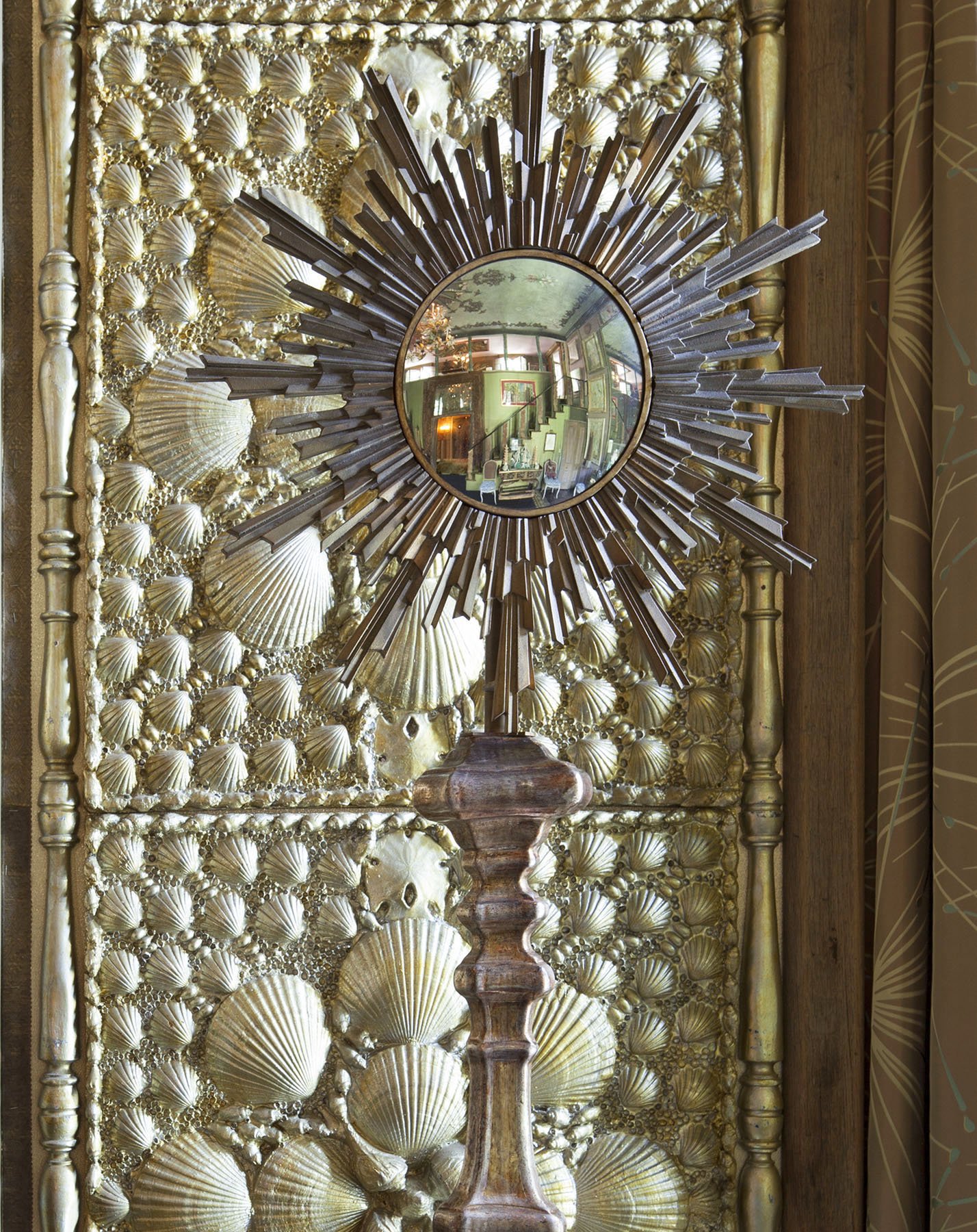
Righteous recycling for the good of the planet might have been an element in Duquette’s technique, but somehow, we doubt it. At his original Hollywood Hills studio, a roomful of 18th-century French antiques sat amid gilded trees beneath a ceiling studded with glued-on gold plastic serving trays. At Dawnridge, a stunning sunburst screen created by Wilkinson would rival an appointment in the court of Louis XIV, made more wonderful by the fact that the gleaming silver half-spheres which compose it are in fact salvaged hubcaps. A priceless, silk-embroidered Chinese robe neatly split in two and applied to large acrylic panels placed on either side of a doorway are known as the “Petrified Pajamas.” Many structural elements, including the looming neo-classical supports that Wilkinson calls “Ironic” (vs. Ionic) columns, are made from industrial scrap, including air filters, metal rods collected from an aircraft landing strip, flattened aluminum take-out containers, and plastic racks fabricated for early computers.
Duquette’s genius for illusion seemed most unfettered when designing costumes and sets for the theatre and the big screen. As a child, he built houses for his toys, illuminated with birthday candles, and put on elaborate puppet-shows --“Scheherezade,” for instance, made fabulous by his hand-sewn costumes. Duquette later built sets for Vincente Minnelli's splashy movies ''Ziegfeld Follies of 1944'' and ''Yolanda and the Thief,'' with Fred Astaire (1945). He then won a Tony Award for best costumes for the original 1961 Broadway production of ''Camelot.'' In 1980s San Francisco, he gained a fervent following with his opera sets and decorations for debutante balls.
This mirthful flirtation of fantasy and artifice also takes us into the darker recesses of the human psyche, much like a journey through Pan’s Labyrinth as conceived by Guillermo del Toro, but only if that murky twilight odyssey had been used as the blueprint for the refurbishment of Disneyland’s Enchanted Tiki-Tiki-Tiki-Tiki Room, art-directed by Liberace. Although Duquette was befriended by Aleister Crowley, the ponderous turgor of Crowley’s esotericism must have amused the insatiably curious and experimental artist. Still, Duquette’s light-hearted juxtapositions can elicit a slight shudder of ghastly humor more in line with a romp through a house of mirrors, a response that philosophers historically attribute to the near-religious experience of what is called the sublime.
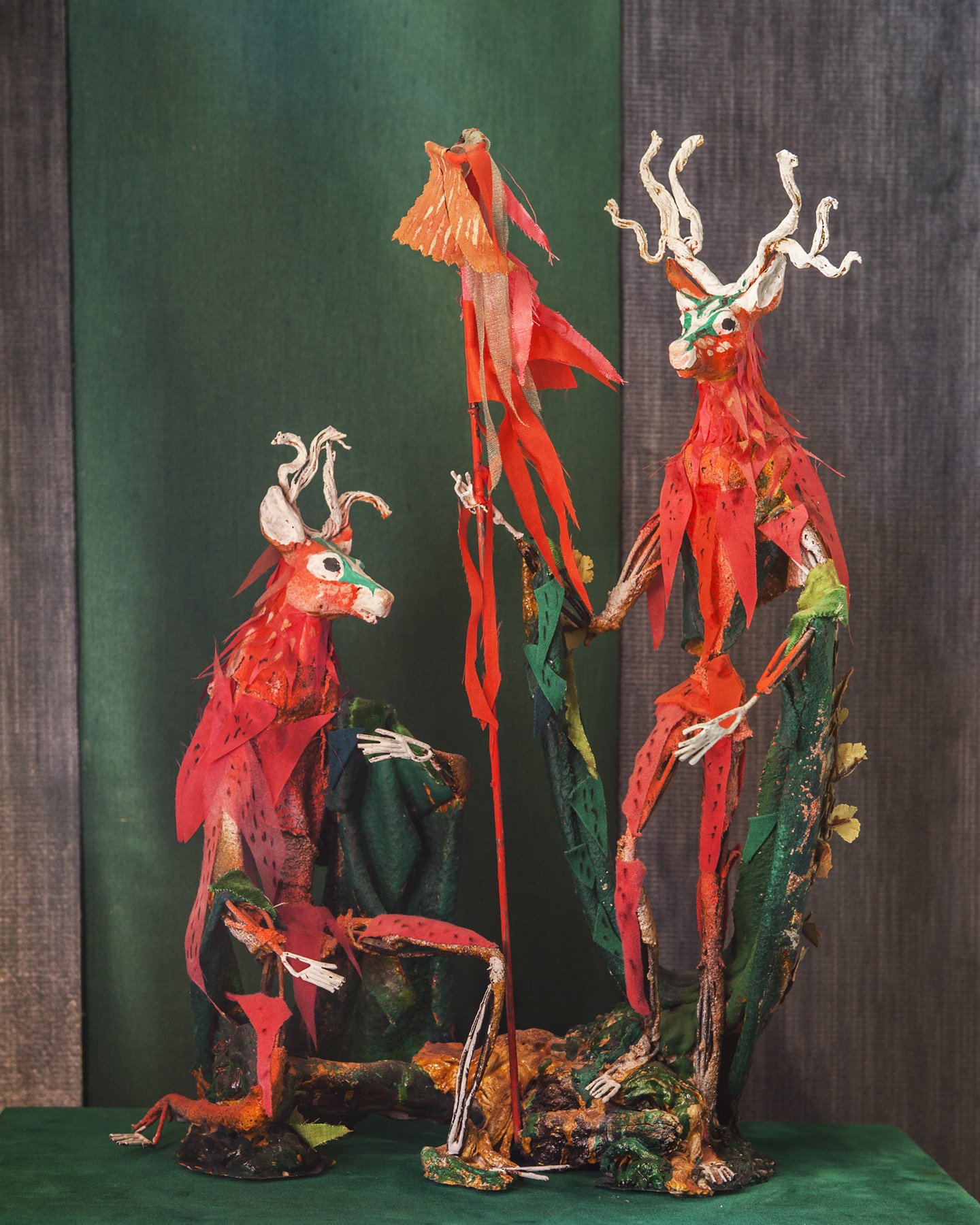
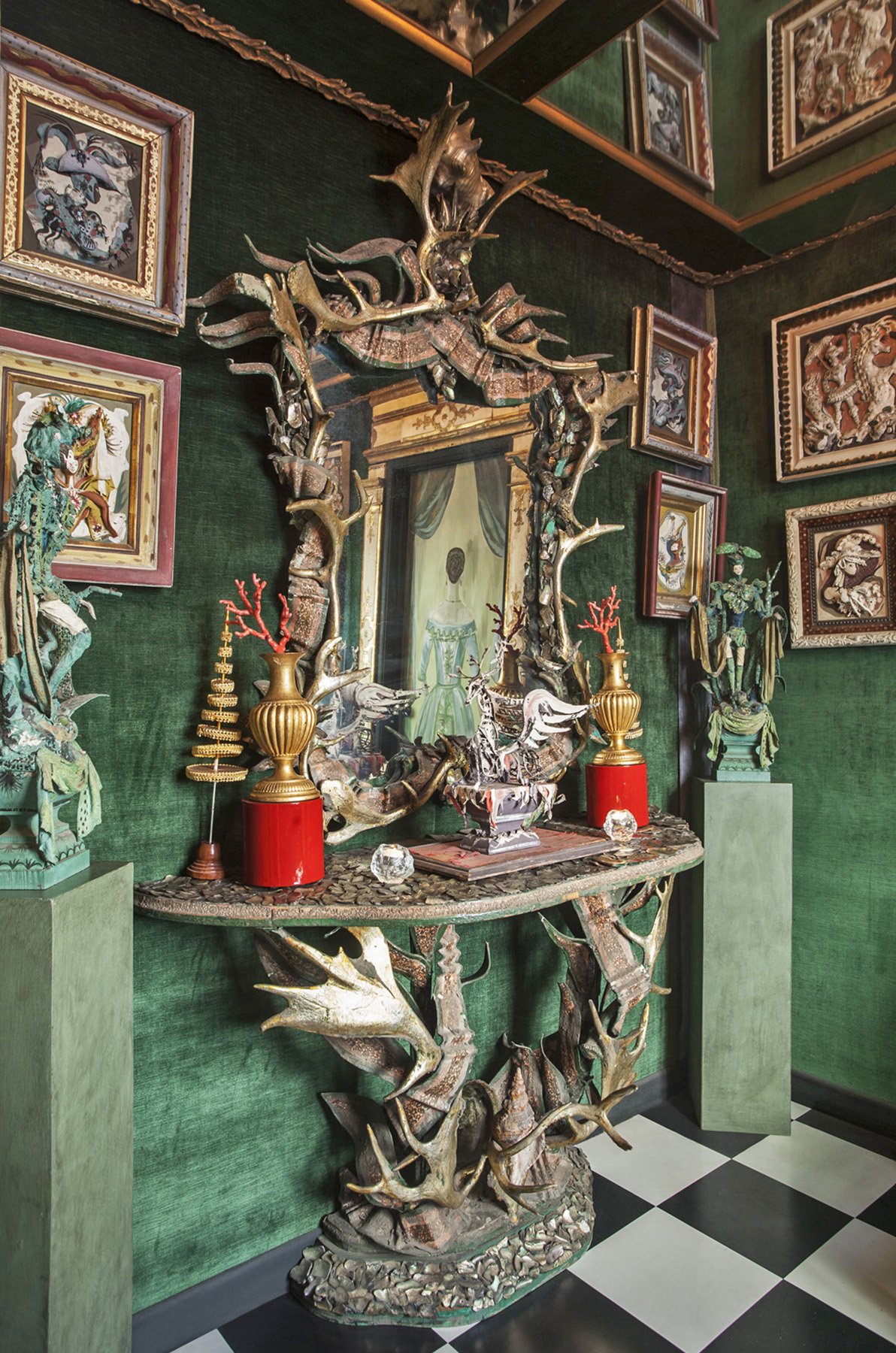
At Dawnridge, this is not a reaction to Duquette’s cheerful use of using cheap materials whenever possible (Wilkinson informed us with a giggle that the expressive monkey-masks which animate the wall of a Indonesian-tropical room were purchased recently at Cost Plus for $1.50 each), but rather recognizing once-living items preserved and altered as part of the mise en scène. In some instances, this has to do with Duquette’s glee in simply taking things too far.
Consider the airplane cabin-scale guest powder room, where the walls gleam with a lustrous covering of deep green, watered silk. Many people theme their bathroom decor to aquatic life with a few seashells or perhaps a framed print of a sailboat or dolphins at play. At Dawnridge, the watery way is manifest in a giant narwhale tusk, rising like a spear in the corner. Elsewhere in the home, the enormous flat, fanged, rostrum (nose extension) of a sawfish looms like an undiscovered Henry Moore or Louise Bourgeoise sculpture. Duquette displayed no squeamishness around taxidermy, as evidenced by a stuffed cockatoo decked out in an elaborate Thai crown. In a vitrine packed with dainty things, a pair of stuffed frogs, the sort commonly sold as souvenirs in Mexican border towns, lift their musical instruments in a silent amphibian serenade to the Muse (although the Muse of precisely what, we’re unsure).
We enjoy a delicious lunch of handmade vegetarian burritos and iced tea, guarded by politically incorrect ceramic Blackamoors, and seated on chairs cast from plastic to resemble precious red Mediterranean coral on a table set with Duquette’s malachite-patterned linen. For centuries, the best-known deposits of malachite were found in the Ural Mountains, and the green veins were fiercely guarded as the sole property of the Czars. Today, the last of this grandeur in the form of malachite columns, vases and furniture fabricated by Auguste Montferrand for Empress Alexandra Fiodorovna, wife of Czar Nicholas I, are preserved at The State Hermitage in St. Petersburg. More recent study reveals that malachite was also mined and treasured as a precious gem in imperial China during the Eastern Zhou period (77-256 BCE), as well as in Palenque, Chiapas, Mexico in the Tomb of the Red Queen (600 – 700 CE), whose cinnabar-dusted sarcophagus was complemented by the queen’s funerary mask composed entirely of malachite mosaic.
Loving this mythopoetic history as well as the trippy stone’s circular, eye-like patterns, Duquette produced malachite-inspired fabrics in red and blue tones as well as the mineral’s own green-range palette, and genuine malachite eggs, obelisks and other objects are present throughout Dawnridge. And amidst the unapologetic chatter of imposters, plaster posing as marble, flecked with glitter and gold spray-paint, one substance surfaces repeatedly: abalone. An abalone chandelier is a Duquette signature. The melty rainbow quality of the polished shell captures the iridescence of Duquette’s mercurial fancies, shimmering, advancing then retreating, morphing fluidly from turquoise to jade to teal to silver to champagne as the light changes.
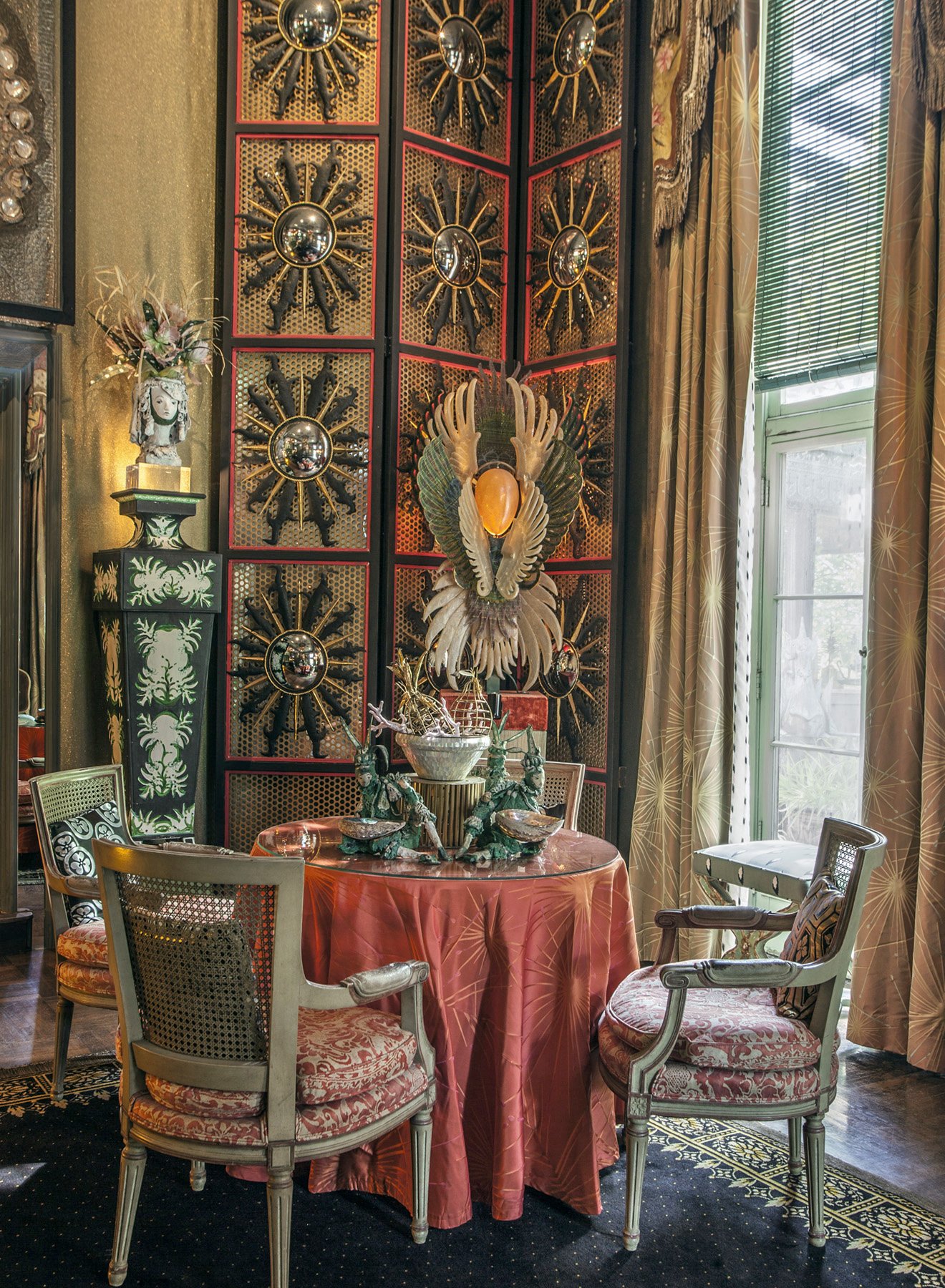

Throughout Dawnridge, we see an image surface persistently: a Gnostic-neo Egyptian, egg-shaped form flanked by flying pectens, wings, rays of light. Duquette referred to this concept, which he rendered several times, as “The Phoenix Rising from His Ashes.” The Duquette vision proved to be flammable as well as incendiary, and several consecutive blazes required that he reinvent himself numerous times. In 1989, The Duquette Pavilion of St. Francis in San Francisco, a monumental space occupied by gigantic sculptures and jeweled tapestries, burned beyond repair, followed by the 1993 burning of his 175-acre Malibu ranch, Sortilegium (the name means sorcery, fortune-telling, soothsaying). However, Dawnridge persists as a shrine of almost terrifying fertility, the treasure-packed rooms leading outdoors to perilously sloping cement steps. The tilting staircase meanders down the hillside amidst a riot of pupping spider plants, orchids, succulents and jacaranda trees, terminating at the banks of a manmade lake where an intricately carved, slightly water-worn dragon-boat drifts placidly on its tether.
There is a faction of art and decor critics who dismiss Duquette as campy, even tacky. And it seems that Duquette, throughout his long life of creative productivity, refused to corset his unruly artistic impulses to please any public. Instead, his ever-seeking mind served as his crucible, continually destroying, adapting, and replenishing his visions. Dawnridge at times may feel like Duquette’s elaborately furnished time-capsule, a Pharaoh-worthy tomb stocked with wares to announce his spangled arrival in the next life. No doubt, he was a man who loved to make a grand entrance. More likely, Dawnridge is Duquette’s DIY spacecraft, furnished with the shamanic, talismanic amulets and sacramental objects needed to fuel his next restless voyage into terra incognito, questing in search of newer, wilder, more iridescent forms of expression.
Is Tony Duquette still on his journey? We’d love to know.
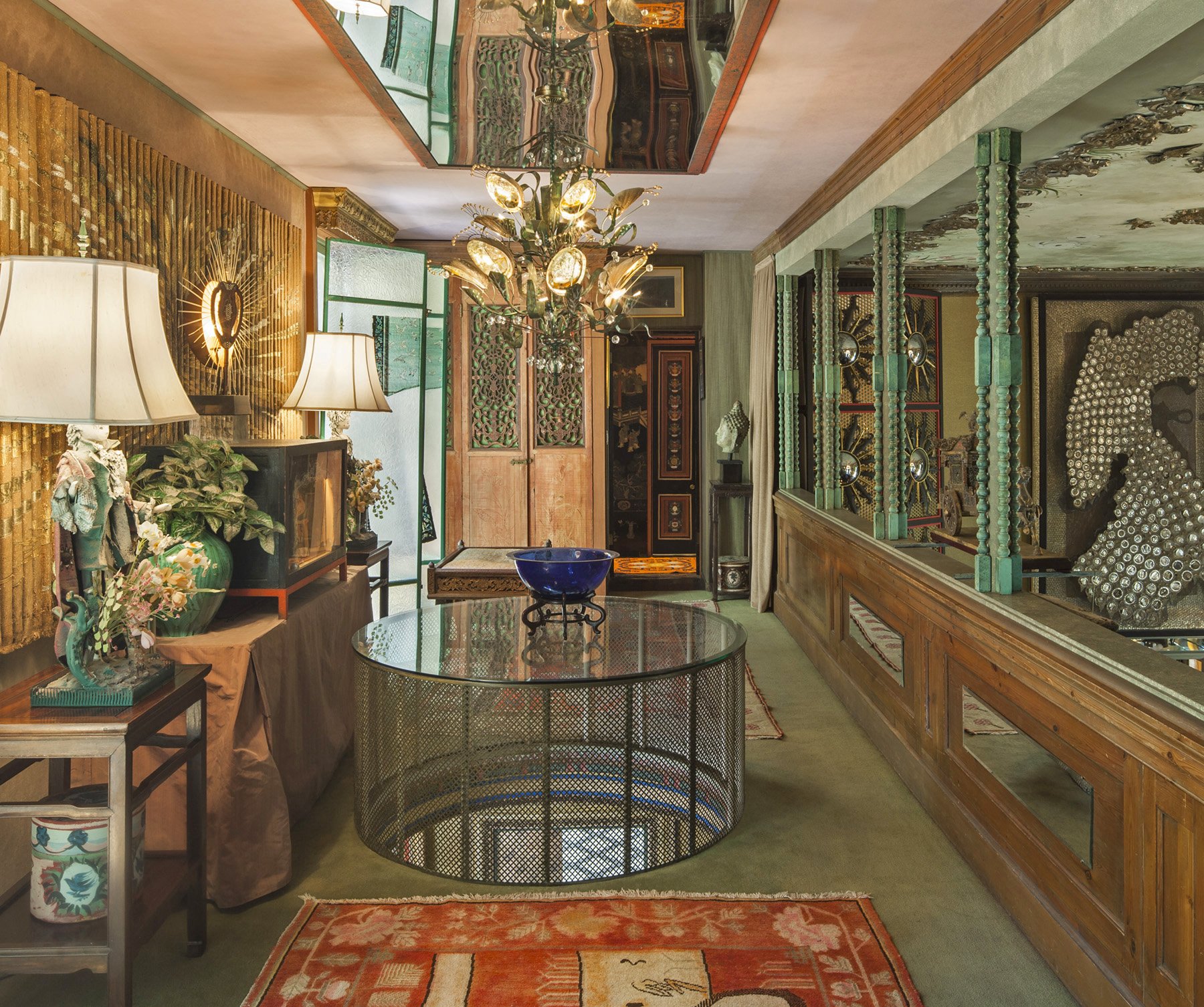
All photos courtesy of Tim Street-Porter.
